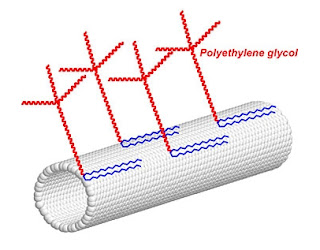Studies in mice already had shown that most nanomaterials tend to accumulate in organs such as the liver and spleen, which was a concern because no one knew how long they could linger. But fears that the tiny tubes might be piling up in vital organs, like discarded refrigerators at the bottom of a rural ravine, can now be put to rest, said Hongjie Dai, the J. G. Jackson and C. J. Wood Professor of Chemistry at Stanford, whose research team has demonstrated that the nanotubes exit the organs.
Previous detection methods that relied on attaching fluorescent labels or spectroscopic tags to the nanotubes had yielded unreliable results. The attachments tended to either come loose from the tubes or decay over time spans ranging from a few days to only a few hours-far too short to reveal the ultimate fate of the nanotubes.
While knowing the carbon nanotubes will move through the digestive system at a healthy pace is critical to future practical applications, it is also crucial that the nanotubes not enter the digestive system too soon after being injected; they need to spend enough time in the circulatory system to find their way to their target location.
The key to fine-tuning the carbon nanotubes' speed of circulation turns on how the basic, bare-bones floor model is chemically accessorized.
''You can make the nanotubes circulate a very long time in the blood, if the chemistry is done right,'' Dai said. The researchers found that coating their carbon nanotubes with polyethylene glycol (PEG), a common ingredient in cosmetics, worked best.
They used a form of PEG with three little limbs sprouting off a central trunk. ''Those provide better shielding to the nanotube than just a single branch. Therefore, they interact less with the biological molecules around them,'' Dai said.
The team stuffed the PEG liberally into the linked hexagonal rings that compose the nanotubes, prompting Dai to describe the end result as resembling rolled-up chicken wire with feathers sticking out all over.
Though they may sound less than gorgeous visually, the feathery nanotubes turned in a beautiful performance in practical terms, Dai said. The coating of PEG made the nanotubes highly water soluble, which helped them to stay in the blood instead of being absorbed.
''They circulate in the blood for about 10 hours or so in mice, which seems to be a good length of time,'' Dai said.
The right chemical coating on nanotubes also can help ease them out of the mouse in a timely fashion, and the three-branched PEG was effective there, too.
Dai's earlier research demonstrated that nanotubes have promise for treating cancer with two different approaches. Once they have zeroed in on the target cells, shining light on the nanotubes causes them to generate heat, which can kill cancer cells. The other method is to rig the nanotubes to accumulate at targeted sites, where they can deliver medication from within the tubes.
''[Carbon nanotubes] seem to be promising for biomedical applications and for potentially treating cancer, either using drugs or using the physical properties,'' Dai said. ''This is the reason we carried out the study of the fate of nanotubes in mice. I think this is really a very fundamental issue.'' ###
The research was funded by the Cancer Center for Nanotechnology Excellence, which is funded by the National Institutes of Health and the National Cancer Institute. The first author of the PNAS paper is Zhuang Liu, graduate student in chemistry. The paper's other authors, all affiliated with Stanford University, are Xiaoyuan ''Shawn'' Chen, assistant professor in radiology; Dr. Corrine Davis of the Veterinary Service Center in the Department of Comparative Medicine; Weibo Cai, postdoctoral scholar in radiology; and Lina He, formerly a technician in Chen's research group.
Contact: Louis Bergeron louisb3@stanford.edu 650-725-1944 Stanford University
Technorati Tags: Nano or Nanotechnology and Nanotech or Stanford University and biomedical applications or John McCain Super Tuesday Speech VIDEO and W.E.B. (William Edward Burghardt) Du Bois and Berkeley Scientists Bring MRI/NMR to Microreactors or Matthew Alexander Henson

















No comments:
Post a Comment